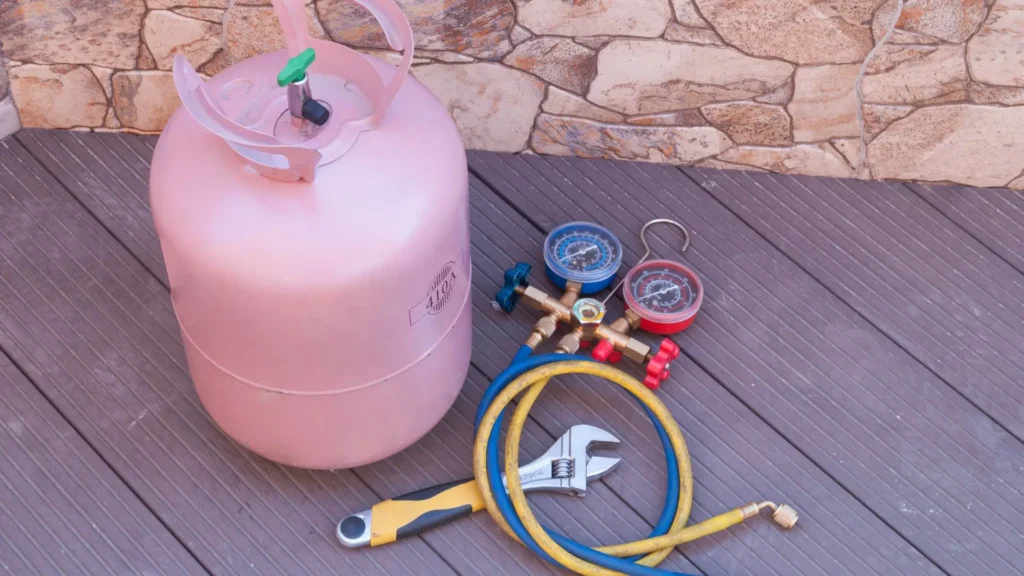If you’re a Hawaii homeowner, you know how brutally hot and humid our summers can be and how that trusty air conditioning unit is basically your best friend. One minute you’re a hot mess, the next you’re basking in that glorious, icy-cold AC breeze.
But what happens when your cooling companion starts acting up and doesn’t quite cool your room anymore? This could indicate that your AC is running low on refrigerant, which is the special liquid that allows your AC unit to suck all the hot, humid air out of your home and replace it with beautiful, crisp, cool air.
You’ll likely notice it’s just not giving you that refreshing blast of cold air like before and it’s causing your monthly utility bills to keep increasing.
The good news is that there are some obvious signs that can clue you in to a refrigerant issue before it becomes a total nightmare scenario. Once you know the red flags to watch out for, you can get it taken care of before the Hawaiian heat drives you completely up the wall. So let’s talk about the top symptoms that your AC’s refrigerant is running on fumes…

What is Refrigerant, and Why Does Your AC Need It?
Okay, let’s back up for a second here. You’ve probably heard this “refrigerant” term thrown around when it comes to AC units. But what exactly is this mystery liquid? And why does your air conditioner absolutely need to have the proper amount?
Refrigerant is a special liquid chemical blend that makes your whole cooling system work by circulating through the AC, absorbing all the hot air inside your home, and releasing it outside. Then it brings back cool air to distribute through the vents.
Your AC is designed as a sealed, closed loop to constantly reuse and recirculate this refrigerant over and over. So it’s not like the stuff just “gets used up” normally from running your AC day-to-day. The only way for levels to get low is if there’s a leak somewhere letting that valuable refrigerant escape.
And having the right refrigerant charge is super crucial for your AC to do its job properly. If levels dip too low, your system just can’t create that refreshing cold air like it’s supposed to. You’ll notice it struggling to take the edge off the heat and humidity no matter how low you crank that thermostat setting.
But it’s more than just discomfort at stake. When refrigerant runs low, it forces your AC to work way harder than it should to try and compensate. That massive strain leads to crazy high energy bills as it runs inefficiently. Not to mention the added wear and tear that’ll likely lead to breakdowns and pricey repair needs down the road.
Common Signs Your AC Needs a Refrigerant Recharge
Alright, so now you know just how vital having the proper amount of refrigerant is for your AC’s performance. But how can you actually tell if your system is running low and needs a recharge? There are some telltale signs you’ll want to keep an eye out for.
Warm Air Blowing from Vents
One of the biggest red flags is warm air blowing from the vents when your AC is running. If refrigerant levels get too low, your system just can’t absorb enough heat and humidity from inside to produce that refreshing cold air like it should. Instead of crisp cooling relief, you get underwhelming warm puffs.
Longer Cooling Cycles and Difficulty Reaching the Set Temperature
Along those same lines, you may notice your AC taking forever to actually cool down your home to the set temperature on the thermostat. Or it may run and run but never quite reach that desired setting at all. That’s because without adequate refrigerant, the system has to work way harder and longer to remove heat effectively.
Hissing or Bubbling Noises
Sometimes you can literally hear signs of trouble too. Odd hissing or bubbling noises coming from the AC unit can potentially indicate a refrigerant leak somewhere in the lines. As that precious cooling liquid escapes, levels drop lower and lower over time.
Ice Build-Up on the AC Coils
Another clue? Check for any ice buildup on the evaporator coils inside the air handler unit. When refrigerant runs low, it can cause those coils to get too cold and freeze over with condensation. That ice acts as insulation, preventing proper heat absorption and cooling.
Rising Energy Bills
Finally, if you’ve noticed a steady increase in your monthly electricity costs but haven’t changed how you use your AC, dwindling refrigerant levels could be the culprit. As the system struggles to compensate for lower refrigerant, it has to run longer cycles and work way harder – seriously spiking your energy usage.
In Hawaii’s scorching summers, running up costly power bills while still feeling hot and sticky is basically a nightmare scenario. If you spot any of those potential red flags, it’s probably time to get your refrigerant levels checked out before the situation gets worse.
Steps to Take if You Suspect Low Refrigerant Levels
Okay, so maybe you’ve noticed some of those telltale signs we just covered, like warm air from the vents or crazy high energy bills. If your spidey senses are tingling that your AC’s refrigerant levels are on the low side, here are some steps you’ll want to take:
Inspect for Visible Signs of Leaks (Without Opening the Unit)
First thing’s first – do a quick visual inspection of your outdoor unit, looking for any obvious signs of a refrigerant leak. You might spot ice buildup on the coils or notice some funky hissing or bubbling noises when the AC kicks on. But don’t try taking the unit apart yourself – refrigerant can be hazardous if not handled properly.
Check Thermostat and Filters
Next up, rule out any other potential simple causes that could be mimicking refrigerant issues. Double check that your thermostat is set correctly and that the air filters aren’t so clogged they’re restricting airflow. A dirty filter can sometimes cause similar cooling problems.
Contact a Licensed HVAC Technician for a Diagnostic Check
If you’ve gone through that process of elimination and still suspect low refrigerant, it’s time to call in the professionals. Only a licensed and trained HVAC technician has the proper tools and know-how to accurately test your system’s refrigerant levels. This isn’t something you want to try recharging or refilling on your own.
Repairing Leaks Before Recharging
Here’s an important point though – if the technician does find a refrigerant leak somewhere in your AC system, they can’t just immediately start topping it off. That leak has to be tracked down and repaired first, or else that fresh refrigerant will just seep out again before you know it. It’s basically like pouring money down the drain.
Once any leaks are sealed up properly, then the tech can finally pull out their gauges and recharge your system with the exact amount of refrigerant it needs per the manufacturer’s specs. This resets your AC back to peak cooling performance so it can keep you comfortable all summer long.
So in summary – inspect for obvious issues first, rule out other causes, but then leave the actual refrigerant testing and recharging to the certified pros who can get it done safely and correctly. Trying to DIY this one can leave you hot under the collar real quick!
Why DIY Refrigerant Recharges Aren’t Recommended
As handy homeowners, we always want to try tackling repairs ourselves to save some cash. But when it comes to messing with your AC’s refrigerant levels, this is one job you’ll definitely want to leave to the trained professionals.
Hazards of Handling Refrigerant
For starters, refrigerants can actually be pretty hazardous if not handled properly. Depending on the specific type, they can be toxic, flammable, or both. Exposure can potentially cause all kinds of nasty health issues like respiratory problems, nausea, or even burns.
Legal Restrictions and Environmental Impact
There are also strict environmental regulations around refrigerant use and disposal because many common refrigerants are greenhouse gases that can contribute to ozone depletion and climate change if released improperly. The EPA has major rules about certification and reclaiming old refrigerants to minimize environmental impact.
Risk of Damaging the AC Unit
But even putting safety concerns aside, attempting a refrigerant recharge on your own is just asking for expensive AC repairs down the road. Using the wrong refrigerant type or overcharging the system can seriously damage internal components like the compressor. That’s an easy way to turn a simple recharge into a costly replacement nightmare.
The bottom line is that refrigerant levels need to be absolutely precise according to the manufacturer’s specs for your specific AC model and size. Going rogue as a DIYer makes it way too easy to get the measurements and pressures out of whack. Before you know it, you’ve got a real cooling catastrophe on your hands.
The Hawaiian Heat is No Match When You Call the Pros
Look, we get it – dealing with potential AC issues is the last thing you want during our scorching summers. But if warm air starts blasting from those vents or your system just can’t seem to keep up, don’t try any reckless DIY fixes with the refrigerant. That’s a one-way ticket to hazardous situations or an expensive repair nightmare.
When refrigerant trouble strikes, your best bet is calling the certified technicians at Steve’s. We have been keeping islanders comfy for years across Maui, Big Island, Oahu, and Kauai.
So, save yourself the headache and potential dangers of attempting a sketchy DIY recharge. Just pick up the phone and dial (808) 563-4054 to request refrigerant service from the Steve’s crew. We’ll get your refrigerant levels dialed in correctly and safely and make sure your AC is back to peak cooling performance in no time!

